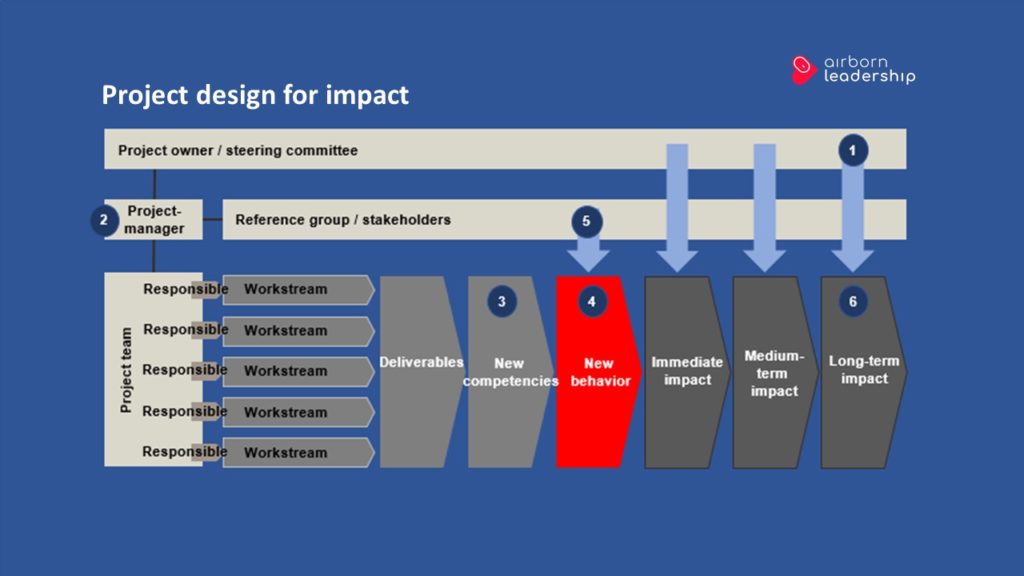As a project leader you have never been more important than now
Yvonne Schoper’s studies show that project economy made up for 34.7% of the German GNP in 2015 and that number will increase to 40% in 2020 (2). There is no reason to believe that the number will be any different in other countries. Soon half of society’s value creation will come from projects!
If we look around us in the world the changes are massive:
- The investments in climate change alone are expected to total 90 billion USD over the next 15 years
- In Europe the average lifetime of a company is 12.5 years
- Half of the 500 largest companies in the world have disappeared in the last 20 years
- Information technology doubles it performance every 18 months
- The collective knowledge in the world doubles every 9 years
During the last 15 years a sheer tsunami of concepts for project management, program management, portfolio management and project maturity has been launched – and still the success rate for projects is a meager 35%. Concepts, tools and techniques don’t hold the entire answer!
Andy Growe (3) shows that 73.9% of all projects fail due to lack of leadership and Peter Morris (4) describes how an active project owner is a basic criterion for success.
The future demands leadership focusing on the strategic effects of the projects
We have to rethink project leadership: We expect that the deliverables create the effect, but in spite of perfect deliverables the effect is lacking. Based on Figure 1 the following adjustments are necessary:
- We can only obtain the long-term business effects if high-level leaders take responsibility for these effects. The project objectives has to be part of the project owner’s goal.
- Since there isn’t consensus in the organization it takes a lot of involvement to define and secure the desired effect. The project manager has to become a project leader.
- The project has to create the competencies that the participants need to master in order to be able to implement the deliverables.
- It is not the deliverables that create the effect but the participants’ competencies and willingness to implement the deliverables. Therefore goals for necessary behavioral changes are needed and the participants should be involved so that they want to make these changes.
- The project can provide the deliverables but the behavioral changes happen with each individual employee in his or her daily work. This is why mid-level managers have to be involved from an early stage and they have to be made responsible for the behavioral changes.
- In order to ensure the realization of the effect objectives the project doesn’t stop until the effect has been obtained.

Figure 1. The structure of the project with the basic theory of change, which indicates the following logical chain: The activities create deliverables and new competencies. The new behavior uses deliverables and competencies so that business effects are created. Source: Project Leadership – Impact on Time (1)
This is a considerable increase in the project leader task. Now it’s not just a technical task to provide the deliverables. The task focuses greatly on handling the stakeholders and leaders at different levels. A common perception of the desired effect has to be created. Support from leaders in the various departments and on different levels has to secured.
Project owner and project leader forms the project leadership
Success projects have an active project owner who hasn’t just placed the order. This active participation, however, cannot undermine the project leader role, so the project owner and the project leader should be working as a leadership team – each with their own individual focus. Their leadership roles can be described by using The Leadership Code (5), which describes five areas good leaders should focus on. These areas can be categorized according to short-term or long-term perspective as well as their focus on individuals or organization. The fifth area focuses on your leadership style:
- To be the strategist and form the future
- To develop the human resource and build the next generation
- To make things happen
- To engage in the current talents and develop them
- To invest in yourself and develop your personal leadership
The last bullet makes up for 30-40% of your leadership efficiency. The way you act, your behavior, your values and your leadership code. Leadership is not about methods, it’s about you! Figure 2 illustrates these roles for the project owner as well as the project leader.
The project owner’s roles first and foremost have an organizational and long-term perspective.
- Driver of the strategic effect. Owns the strategic goals and should clear the way for the project effect in the organization and eliminate impediments and unnecessary bureaucracy. It is the project owner who should create and communicate the narrative about the project’s strategic importance in the organization.
- Power executor, facilitator and negotiator. Must use his or her influence and secure the necessary resources of highly qualified participants. He or she should negotiate and facilitate the necessary processes, so that management, mid-level managers and key stakeholders support the project.
- Accelerator of behavioral and other changes. Must clear the way for the organizational changes and set the pace including insurance that the relevant groups of employees obtain the necessary new competencies and actually change behavior. This task is mainly about building trust in key persons and mid-level managers.
- Leading the project leader. A crucial task is to motivate and inspire the project leader so that he or she can perform as a leader. The project owner should make sure that the leadership task makes sense for the project leader and give qualified feedback, making it possible for the project leader to improve his or her leadership. Still the project leader has to have the room to maneuver.

Figure 2. The roles of the project owner and project managers. The blue shades indicate the weight of the leadership task in question. The darker the blue, the more comprehensive is this role in the project work. Inspired by The Leadership Code, Dave Ulrich (5).
The project leader’s roles are primarily active during the project period but with a strategic perspective.
- Driver of the project effect. Create coherence between organization strategy and project effect objectives. You have to create a logical coherence between the project effects, deliverables, effort areas and resource allocation. Be loyal to the effects and flexible with the deliverables. Remember that no business effect is ever achieved without new competencies and new behavior in the target group.
- Planner, organizer and facilitator. Plan and organize the process with short learning loops and the biggest possible involvement of the target group. Facilitate interactions and motivate the project team, leaders and key stakeholders. Create relations and strong alliances with the most important players.
- Leader of the participants and team. Put participants before structure and create meaning and purpose for each individual. Let them plan their own work responsibly. Give honest and constructive feedback in order for everybody to develop during the process. Try to hand everybody challenging and interesting tasks. Each individual should be assured that they are participating because the project needs exactly their competencies. Be appreciative and share success and credit abundantly.
- Train and mature behavioral changes. Establish the necessary training of the target group in an engaging and motivating manner. Clear the way for the target group’s behavioral changes through involvement, listening and using change communication.
Invest in yourself as a leader
Your impact as a leader is essentially about your personal leadership competencies and your leadership style. This is why you constantly have to reflect on and develop your leadership. But you cannot reflect on your leadership unless you realize what you do when you lead. Therefore you have to develop your personal leadership model. You can do that by answering these questions:
- What do you think motivates your project participants and stakeholders?
- Know yourself. Why do you want to lead other people? What is your incentive?
- Which basic values do you have in your leadership? What is your leadership code?
- What is the main challenge in the project you are leading? The task, the environment, the situation, the resources etc. Accept the conditions and adjust your leadership to the environment.
Once you have a clear picture of how you want to lead it will be easier for you to reflect on what happened in a certain situation. Realize what you want, observe the effect and adjust your leadership!
In our future project based society the jobs will be in your project
We have been in an efficiency paradigm focusing on optimization but it doesn’t make sense to optimize when the lifespan of processes, technology and products is becoming increasingly short.
In the future we will be in an innovation paradigm where the effect will be greater by combining the vast amount of new possibilities.
This is why future jobs will be in the projects. Project leadership is the future leadership. Climate change challenges alone is expected to demand investments in new infrastructure of 90 billion USD during the coming 15 years.
This means that the organizations’ leaders will have to use more time on change and delegate the operation. Project owner will be more active in the projects which demands a very tight prioritization using few short intensive projects.
“Leadership is about creating new realities” Peter M. Senge.
A few years back the engineer and economist unions in Denmark carried out a stress survey among their members. It showed that project work was a major stress factor. So you and your project owner has a great responsibility on your shoulders. Your leadership team creates the future, but it is happening in an uncertain and complex process under great pressure which can easily overwhelm the project participants and employees if not performed in a sustainable way.
References
- Ryding Olsson, John. Projektlederskabet – effekt til tiden, DJØF’s Forlag 2016, ISBN 978-87-574-2224-5.
- Dr. Yvonne Schoper, MTV, Berlin. Makroökonomische Vermessung der Projekttätigkeit in Deutschland, 2015.
- Growe, Andy. Alpha Project Managers: What the Top 2% Know That Everyone Else Does Not. Velociteach, 2016. ISBN-13: 978-0990907411
- Morris, Peter W.G. Reconstructing Project Management, Wiley-Blackwell, 2013. ISBN 978-0-470-65907-6
- Ulrichs, Dave. The Leadership Code: Five Rules to Lead by: The Five Things Great Leaders Do. Harvard Business School Press, 2009. ISBN-13: 978-1422119013




